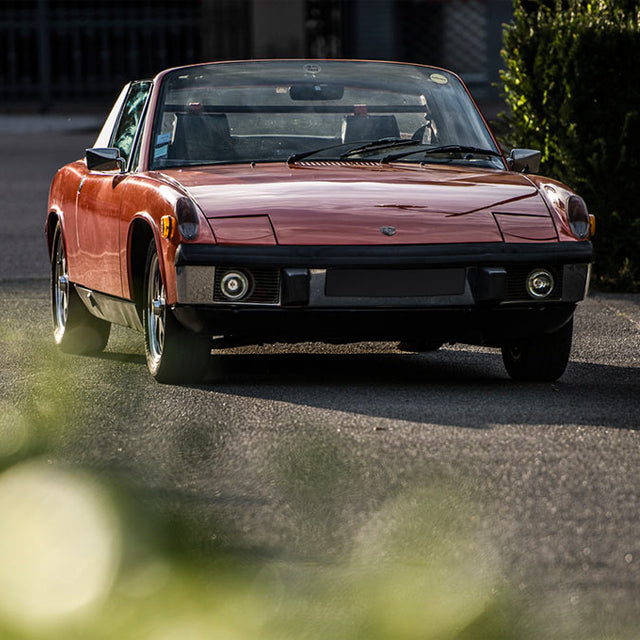Photography by Rémi Dargegen for Petrolicious
The Collector is a weekly series produced in association with Gear Patrol, where we discuss the car, and Gear Patrol discusses the essential gear inspired by the car. (Click here to see the rest of The Collector Series on Petrolicious).
By whatever fractious means it came to exist, the Porsche 914 represented something very special when it graced American showrooms in 1969. The Detroit horsepower wars were going great guns when this unusual and beautiful Targa-roofed, mid-engined sports car arrived from Germany. It was like a tiny Ferrari or Lamborghini, approximately the kind of thing Lotus had pursued with the Europa, exotic and a bit delicate-looking. Yet fragility was not an inherent part of the equation. After all, the 914 came not from some small workshop in limited numbers but from Porsche, which was part of the great German automotive complex. By 1976, global sales would be impressive for a car of such limited utility, with about 118,000 of the four-cylinder models and another 3351 of the sixes finding buyers.

The initial offering gave those buyers the choice of a fuel-injected 1.7-liter Volkswagen four, which was anemic and universally derided, or the carbureted, overhead-cam, 2.0-liter horizontally opposed six. The latter engine was peaky and could be made to do great things–sixth overall at the 24 Hours of LeMans in 1970, for example–but its low take rate demanded a more suitable replacement. This came in 1973, when the fuel-injected variant of Volkswagen’s air-cooled Type 4 engine was dropped in behind the two seats, staying there through 1976, when series production ended. (The engine continued on in the 912E, which succeeded the 914 as Porsche’s entry-level car.) The short-stroke, overhead-valve powerplant displaced 2.0 liters (1971 cc) and made its 100 hp at 5000 rpm, whereas the six had made 110 hp at 5800 rpm. Yet the four matched the six’s torque output of 118 lb-ft, achieving this figure at 3500 rpm instead of 4200 rpm. And it was lighter in weight.
Of course these numbers seem laughable in view of the orgy that was going on inside just about any car from Detroit. But the petite Porsche 914 slipped over the scale at 2094 lb. The key, as ever, was balanced performance, which came through good throttle response and the five-speed manual gearbox. Acceleration was so-so, with 0 to 62 mph being achieved in 10.5 seconds, but top speed of 118 mph wasn’t at all bad. (The ferocious, flat-out clatter could levitate people from the seats, though.) Besides all this, nimbleness was the 914’s calling card. Suspension was fully independent, which remained something of a novelty in the early and mid-1970s. Anti-roll bars firmed up the cornering response. And of course, four-wheel disc brakes were used, although the lack of power assistance meant that firm pedal pressure was required.
The lightweight, mid-engined formula has since been repeated in the Toyota MR2, and Porsche has kept them coming, too, first with the Boxster and soon with the forthcoming 718. But the assertive stance and crisp lines have kept the original 914’s desirability undiminished.



As far as the collector is concerned, the 914 has fallen victim to its own success. Dropping in on an owners’ forum will reveal the myriad tips for autocrossing and track-worthy upgrades, and therein lies the story. Finding an original example might be a challenge–especially one of the 1974 Limited Edition models in Can-Am racing series livery.
Then again, you might be as astute as Sahara Beige Steve, a 914 World forum member who purchased a 23,000-mile, 1973 914 from its original owner in 1998. The base price, shown on the window sticker from Rusnak Porsche Audi, of Pasadena, California, was $5800, and the beige paint was a $330 option, with another $100 for some useful window tinting.
An example this nice would bring right around $30,000, according to Hagerty’s price guide report. Or you could spend nearly the same on some off-balance muscle car–with the remaining dollars held in reserve for the supply of adult diapers you and your passengers will need with each ride.
If you'd like more on the Porsche 914, check out our video, here.
Thank you to Mr. Coulon for allowing us to photograph his car.


Small Makes it Big
While Porsche and sports car purists might laugh at the diminutive 914, it has racing chops it can brag about, unlike so many sports cars in history that might be much faster but lack any real racing pedigree. In nearly the same spirit as the tiny but quick Porsche 550 from the 1950s, the racing version of the 914, the 914/6 GT entered the grueling 24 Hours of Le Mans in 1970 and came away with the GT Class (under 2,000 ccs) victory and a seriously impressive 6th place overall — just behind the legendary Porsche 917K and Ferrari 512 S, both of which had twice as many cylinders. How’s that for tiny terror?
Written by Amos Kwon of Gear Patrol































































